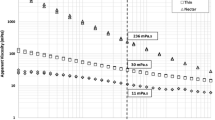Abstract
Tongue–soft palate coordination and bolus head pharyngeal transit were studied by means of postacquisition kinematic analysis of videofluoroscopic swallowing images of ten preterm infants referred from hospital NICUs due to poor oral feeding and suspicion of aspiration. Sequences of coordinated tongue–soft palate movements and bolus transits during swallows of thin-consistency and nectar-thick-consistency barium were digitized, and time series data were used to calculate continuous relative phase, a measure of coordination. During swallows of nectar-thick compared to thin barium, tongue–soft palate coordination was more likely to be antiphase, bolus head pharyngeal transit time was longer, and coordination was significantly correlated with bolus head pharyngeal transit. Analysis of successive swallows indicated that tongue–soft palate coordination variability decreased with nectar-thick but not with thin-consistency barium. Together, the results suggest that slower-moving bolus transits may promote greater opportunity for available sensory information to be used to modulate timing of tongue–soft palate movements so that they are more effective for pumping liquids.







Similar content being viewed by others
References
Goldfield EC, et al. Coordination of sucking, swallowing, and breathing and oxygen saturation during early infant breast-feeding and bottle-feeding. Pediatr Res. 2006;60(4):450–5.
Rogers B, Arvedson J. Assessment of infant oral sensorimotor and swallowing function. Ment Retard Dev Disabil Res Rev. 2005;11(1):74–82.
Arvedson JC, Brodsky L. The airway and swallowing. In: Arvedson JC, Brodsky L, editors. Pediatric swallowing and feeding: assessment and management. Albany: Singular Publishing Group; 2002. p. 153–85.
Vazquez JL, Buonomo C. Feeding difficulties in the first days of life: findings on upper gastrointestinal series and the role of videofluoroscopic swallowing study. Pediatr Radiol. 1999;29:894–6.
Stuart S, Motz JM. Viscosity in infant dysphagia management: comparison of viscosity of thickened liquids used in assessment and thickened liquids used in treatment. Dysphagia. 2009;24:412–22.
Dengel D, Robbins J, Rosenbek J. Image processing in swallowing and speech research. Dysphagia. 1991;6:30–9.
Mercado-Deane MG, et al. Swallowing dysfunction in infants less than 1 year of age. Pediatr Radiol. 2001;31(6):423–8.
Bosma JF, et al. Ultrasound demonstration of tongue motions during suckle feeding. Dev Med Child Neurol. 1990;32(3):223–9.
Bu’Lock F, Woolridge MW, Baum JD. Development of co-ordination of sucking, swallowing and breathing: ultrasound study of term and preterm infants. Dev Med Child Neurol. 1990;32(8):669–78.
Miller JL, Kang SM. Preliminary ultrasound observation of lingual movement patterns during nutritive versus non-nutritive sucking in a premature infant. Dysphagia. 2007;22(2):150–60.
Pouderoux PK, Kahrilas PJ. Deglutitive tongue force modulation by volition, volume, and viscosity in humans. Gastroenterology. 1995;108:1418–26.
Miller JL, Watkin KL. The influence of bolus volume and viscosity on anterior lingual force during the oral stage of swallowing. Dysphagia. 1996;11:117–24.
Lazarus CL, et al. Effects of bolus volume, viscosity, and repeated swallows in nonstroke subjects and stroke patients. Arch Phys Med Rehabil. 1993;74(10):1066–70.
Bisch EM, Logemann JA, Rademaker AW, Kahrilas PJ. Pharyngeal effects of bolus volume, viscosity, and temperature in patients with dysphagia resulting from neurologic impairment and in normal subjects. J Speech Hear Res. 1994;37:1041–9.
Perlman AL, Vandaele DJ, Otterbacher MS. Quantitative assessment of hyoid bone displacement from video images during swallowing. J Speech Hear Res. 1995;38:579–85.
Ishida R, Palmer JB, Hiiemae KM. Hyoid motion during swallowing: Factors affecting forward and upward displacement. Dysphagia. 2002;17:262–72.
Kendall KA, et al. Timing of events in normal swallowing: a videofluoroscopic study. Dysphagia. 2000;15(2):74–83.
Goldfield EC, et al. Premature infant swallowing: Patterns of tongue–soft palate coordination based upon videofluoroscopy. Infant Behav Dev. 2010;33:209–18.
Dantas RO, et al. The effect of high- vs low-density barium preparations on the quantitative features of swallowing. AJR Am J Roentgenol. 1989;153(6):1191–5.
Dantas RO, et al. Effect of swallowed bolus variables on oral and pharyngeal phases of swallowing. Am J Physiol. 1990;258(5 Pt 1):G675–81.
Steele CM. Searching for meaningful differences in viscosity. Dysphagia. 2005;20(4):336–8.
Jafari S, et al. Sensory regulation of swallowing and airway protection: a role for the internal superior laryngeal nerve in humans. J Physiol. 2003;550(Pt 1):287–304.
Bloch-Salisbury E, et al. Stabilizing immature breathing of preterm infants using stochastic mechanosensory stimulation. J Appl Physiol. 2009;107:1017–27.
Batschelet E. Circular statistics in biology (mathematics in biology). New York: Academic Press; 1981.
Hoon AH, et al. Sensory and motor deficits in children with cerebral palsy born pretermcorrelate with diffusion tensor imaging abnormalities in thalamocortical pathways. Dev Med Child Neurol. 2009;51:697–704.
Steele CM, Miller AJ. Sensory input pathways and mechanisms in swallowing. Dysphagia. 2010;25:323–333.
Ting LH, McKay JL. Neuromechanics of muscle synergies for posture and movement. Curr Opin Neurobiol. 2007;17(6):622–8.
Acknowledgments
This research was supported by NIH Grant R01 DC 007127 (to the first author) and by NIH Grant P01 HD18655 to the Children’s Hospital Intellectual and Developmental Disabilities Center. Thanks to Joan Arvedson, Rebecca German, and Jeff Palmer for encouragement and advice, and to Fuzz Crompton for the Fig. 1 line drawing.
Conflict of interest
None.
Author information
Authors and Affiliations
Corresponding author
Rights and permissions
About this article
Cite this article
Goldfield, E.C., Smith, V., Buonomo, C. et al. Preterm Infant Swallowing of Thin and Nectar-Thick Liquids: Changes in Lingual–Palatal Coordination and Relation to Bolus Transit. Dysphagia 28, 234–244 (2013). https://doi.org/10.1007/s00455-012-9440-y
Received:
Accepted:
Published:
Issue Date:
DOI: https://doi.org/10.1007/s00455-012-9440-y




